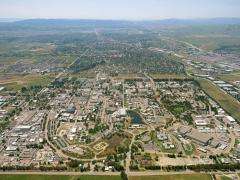Scientists Produce Unprecedented 1 Megajoule Laser Shot, Step Towards Fusion Ignition

US scientists have produced a laser shot with an unprecedented energy level that could be a key step towards nuclear fusion, the US National Nuclear Security Administration said Wednesday.
The National Nuclear Security Administration announced today that scientists at the National Ignition Facility (NIF) at Lawrence Livermore National Laboratory (LLNL) have successfully delivered an historic level of laser energy — more than 1 megajoule — to a target in a few billionths of a second and demonstrated the target drive conditions required to achieve fusion ignition. This is about 30 times the energy ever delivered by any other group of lasers in the world.
The peak power of the laser light, which was delivered within a few billionths of a second, was about 500 times that used by the United States at any given time.
“Breaking the megajoule barrier brings us one step closer to fusion ignition at the National Ignition Facility, and shows the universe of opportunities made possible by one of the largest scientific and engineering challenges of our time,” said NNSA Administrator Thomas D’Agostino. “NIF is a critical component in our stockpile stewardship program to maintain a safe, secure and effective nuclear deterrent without underground nuclear testing. This milestone is an example of how our nation’s investment in nuclear security is producing benefits in other areas, from advances in energy technology to a better understanding of the universe.”
In order to demonstrate fusion, the energy that powers the sun and the stars, NIF focuses the energy of 192 powerful laser beams into a pencil-eraser-sized cylinder containing a tiny spherical target filled with deuterium and tritium, two isotopes of hydrogen. Inside the cylinder, the laser energy is converted to X-rays, which compress the fuel until it reaches temperatures of more than 200 million degrees Fahrenheit and pressures billions of times greater than Earth’s atmospheric pressure. The rapid compression of the fuel capsule forces the hydrogen nuclei to fuse and release many times more energy than the laser energy that was required to initiate the reaction.
This experimental program to achieve fusion ignition is known as the National Ignition Campaign sponsored by NNSA and is a partnership among LLNL, Los Alamos National Laboratory, the Laboratory for Laser Energetics, General Atomics, Sandia National Laboratories, as well as numerous other national laboratories and universities.
The NIF laser system, the only megajoule laser system in the world, began firing all 192-laser beams onto targets in June 2009. In order to characterize the X-ray drive achieved inside the target cylinders as the laser energy is ramped up, these first experiments were conducted at lower laser energies and on smaller targets than will be used for the ignition experiments. These targets used gas-filled capsules that act as substitutes for the fusion fuel capsules that will be used in the 2010 ignition campaign. The 1 MJ shot represents the culmination of these experiments using an ignition-scale target for the first time.
These early tests have demonstrated that NIF's laser beams can be effectively delivered to the target and are capable of creating sufficient X-ray energy in the target cylinder to drive fuel implosion. The implosions achieved with the surrogate capsules have also been shown to have good symmetry that is adjustable through a variety of techniques. The next step is to move to ignition-like fuel capsules that require the fuel to be in a frozen hydrogen layer (at 425 degrees Fahrenheit below zero) inside the fuel capsule. NIF is currently being made ready to begin experiments with ignition-like fuel capsules in the summer of 2010.
“This accomplishment is a major milestone that demonstrates both the power and the reliability of NIF’s integrated laser system, the precision targets and the integration of the scientific diagnostics needed to begin ignition experiments,” said NIF Director Ed Moses. “NIF has shown that it can consistently deliver the energy required to conduct ignition experiments later this year.”
NIF, the world’s largest laser facility, is the first facility expected to achieve fusion ignition and energy gain in a laboratory setting.
Provided by National Nuclear Security Administration



















